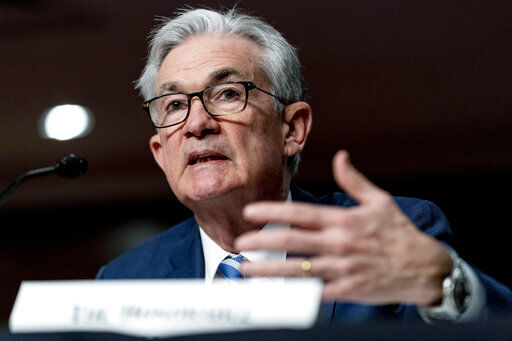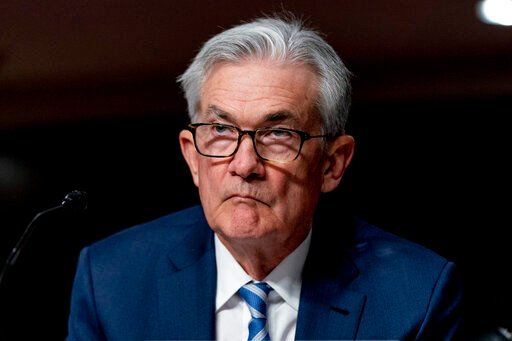WASHINGTON (AP) — The Federal Reserve will quicken the pace at which it’s pulling back its support for the economy as inflation surges, and it expects to raise interest rates three times next year.
In a sharp policy shift, the Fed announced Wednesday that it will shrink its monthly bond purchases at twice the pace it previously announced, likely ending them altogether in March. The accelerated timetable puts the Fed on a path to start raising rates in the first half of next year.
The Fed’s new forecast that it will raise its benchmark short-term rate three times next year is up from just one rate hike it had projected in September. The Fed’s key rate, now pinned near zero, influences many consumer and business loans, including for mortgages, credit cards and auto loans.
Those borrowing costs may start to rise in the coming months, though the Fed’s actions don’t always immediately affect other loan rates. And even if the central bank does raise rates three times next year, it would still leave its benchmark rate historically low, below 1%.
The policy change the Fed announced Wednesday had been signaled in testimony Chair Jerome Powell gave to Congress two weeks ago in discussing the extraordinary support the Fed supplied the economy after the pandemic struck last year. The shift reflects Powell’s acknowledgement that with inflation pressures rising, the Fed needed to begin tightening credit for consumers and businesses faster than he had thought just a few weeks earlier. The Fed had earlier characterized the inflation spike as mainly a “transitory” problem that would fade as supply bottlenecks caused by the pandemic were resolved.
The run-up in prices has persisted longer than the Fed expected and has spread from goods like food, energy and autos to services like apartment rents, restaurant meals and hotel rooms. It has weighed heavily on consumers, especially lower-income households and particularly for everyday necessities, and negated the higher wages many workers have received.
Powell was asked at a news conference Wednesday what specifically had caused the Fed to pivot to a tighter credit policy.
“It was essentially higher inflation and much faster progress in the labor market,” he said.
He acknowledged the possibility that inflation won’t decline as expected next year.
“There’s a real risk now,” Powell said, “that inflation may be more persistent and that may be putting inflation expectations under pressure, and that the risk of higher inflation becoming entrenched has increased. I think part of the reason behind our move today is to put ourselves in a position to be able to deal with that risk.”
As a result, the Fed is shifting its attention away from reducing unemployment, which has fallen quickly to a healthy 4.2%, down from 4.8% at its last meeting, and toward reining in higher prices. Consumer prices soared 6.8% in November compared with a year earlier, the government said last week, the fastest pace in nearly four decades.
On Wall Street, stock prices rose gradually and then surged after the Fed issued its statement, and Powell began speaking at a news conference. By the time Powell finished, the Dow Jones Industrial Average had jumped more than 300 points.
The Fed’s policy change does carry risks. Raising borrowing costs too fast could stifle consumer and business spending. That, in turn, would weaken the economy and likely raise unemployment.
Yet if the Fed waits too long to raise rates, inflation could surge out of control. It might then have to act aggressively to tighten credit and potentially trigger another recession.
Fed officials have said they expect inflation to cool by the second half of next year. Gas prices have already come off their peaks. Supply chain bottlenecks in some areas are gradually easing. And government stimulus payments, which helped spur a spike in spending that boosted inflation, aren’t likely to return.
Yet many economists expect high prices to persist. That likelihood was reinforced this week by a government report that wholesale inflation jumped 9.6% for the 12 months ending in November, the fastest year-over-year pace on records dating to 2010.
Housing costs, including apartment rents and the cost of homeownership, which make up about one-third of the consumer price index, have been rising at a 5% annual pace the past few months, economists at Goldman Sachs have calculated. Restaurant prices jumped 5.8% in November from a year ago, a nearly four-decade high, partly reflecting higher wage costs. Such increases will likely keep inflation well above the Fed’s 2% annual target next year.
The Fed’s monthly bond purchases were intended to hold down long-term rates to aid the economy, but with unemployment falling and inflation at a near-40-year high, they are no longer needed.
At his news conference, Powell noted that consumers — the leading driver of the economy — remain on solid footing.
“Fundamentally,” he said, “the consumer is really healthy, and we expect personal consumption expenditures to be pretty strong” in the current fourth quarter of the year.
———
AP Economics Writer Martin Crutsinger contributed to this report.



